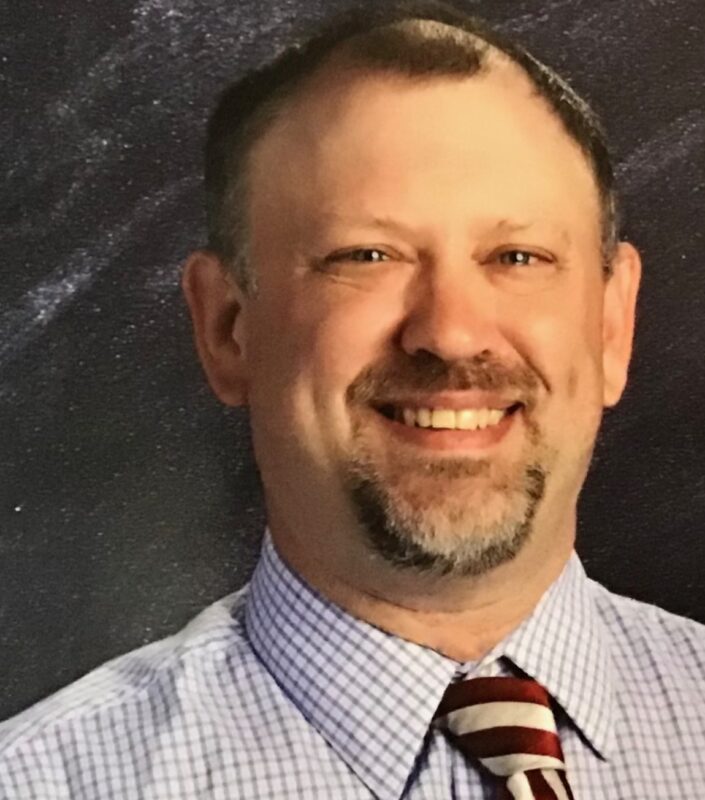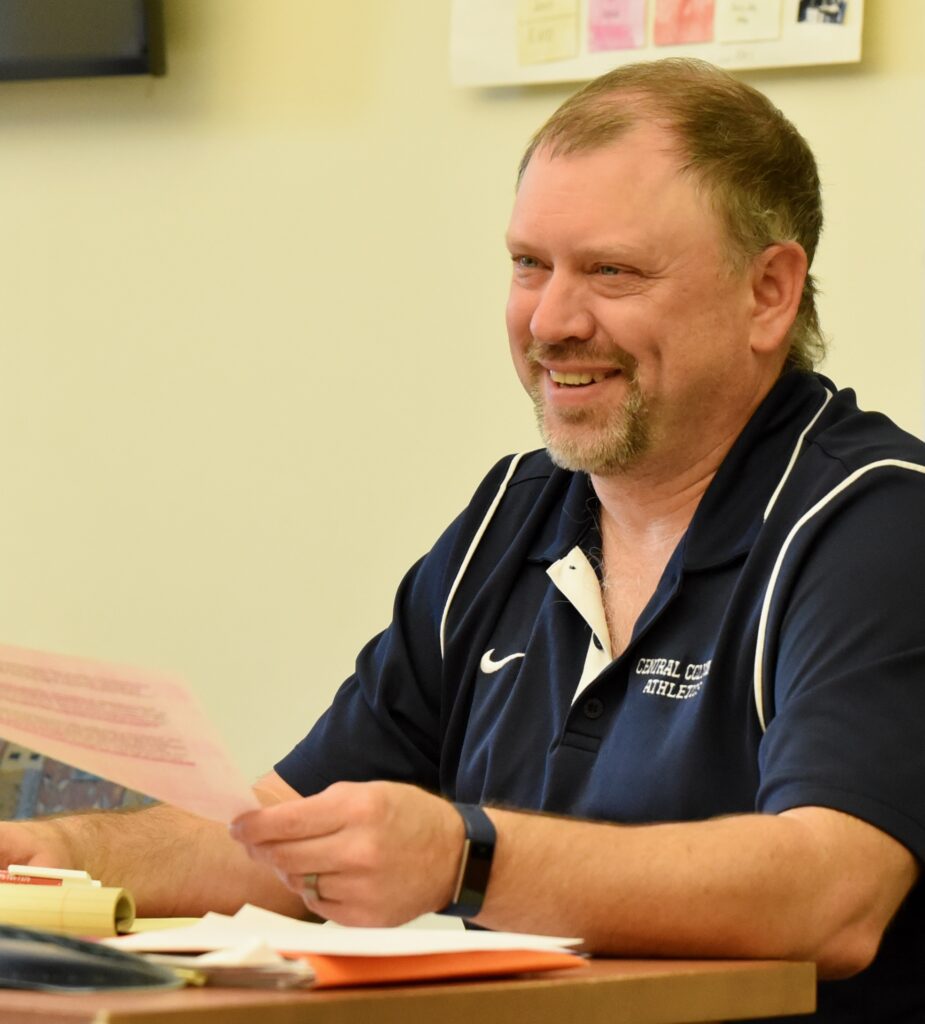Meet Our Teachers
Lance Miller

The Power of Gratitude
After graduating with a Master of Arts in American History and Government, Lance Miller wrote every professor in the MAHG program a thank-you note. “Most of those professors probably don’t remember me, but they should know I appreciated them,” Miller said.
When asked about Miller, Professor Jason Jividen immediately responded. “I had Lance in the Progressivism course and a great American text course (Tocqueville’s Democracy in America). He is a spirited and thoughtful guy and his contribution to our discussions made these classes better for all of us. I’d bet he’s a very good teacher.”
Miller “knew the material and was always engaged,” said Professor Joshua Dunn, who taught last summer’s course on Freedom and Equality in Constitutional Law. “I could count on him to keep the conversation going, even in a session right after lunch when everyone was tired and ready for a nap.”

Professor Rob McDonald remembered Miller making “insightful comments” from “the porch of his house in Pennsylvania” during summer 2020, when COVID forced the MAHG residential program to move to WebEx. “Lance lives near the historic home of Joseph Priestley (1733-1804), an English-born Jeffersonian who, among other things, discovered oxygen. He’s invited me to come visit. He’d better look out, because I just might!”
One often hears MAHG students speaking gratefully about the program’s excellent faculty. Faculty reciprocate this respect and gratitude. They see the teachers who study in the program as colleagues equally devoted to studying and teaching our nation’s history and institutions. “It’s the best teaching experience I have all year,” many faculty members say.
Still, in Lance Miller’s case, the gratitude is palpable, extending beyond his MAHG experience. It makes him an effective teacher and department chair at Central Columbia School District in northeastern Pennsylvania.
Called to a New Teaching Post
The small district has one elementary, one middle, and one high school. Nine years ago, Miller was asked to move from the high school to the middle school, to teach eighth grade American history. It was part of a staff reduction that hit social studies teachers in particular. “I was very disappointed, because I had never applied for that job and wasn’t ready for it.
“But today, I do love who I teach, what I teach, and who I teach with,” Miller said.
He has completely reoriented his teaching focus. He uses primary documents, as he always has, ever since experiencing this approach to history as an undergraduate at Bloomsburg University. But now his main task is developing students’ reading competency.
How Students Learn to Read Closely
“I tell my students: I need you to read everything three times.” The first assignment is an excerpt of the travel journal of Christopher Columbus. Students first read it in class, working in pairs and reading the text out loud to each other. Reading out loud “slows the reading down,” Miller says.
To take in what a primary document offers, even fluent readers must slow down. “Reading fluently doesn’t mean you can read well,” Miller says. “I’m a slow reader myself. I will read a paragraph and then say, ‘What did I just read?’” To help students focus, Miller asks them during this first reading to “circle vocabulary you don’t know and highlight the words and phrases you think are important.”
During the second reading, students summarize each paragraph in the margin. With the third reading, “we get into the MAHG-type analysis,” Miller says. “I ask students to identify the author’s purpose” as well as any “hidden agenda” behind the writing. For example, “Columbus writes his journal for Ferdinand and Isabella, speaking as their devoted servant and emissary for Christianity. Reading between the lines, you can guess he’s trying to acquire money and status. He’s willing to take advantage of the natives to achieve this.”
Putting the Revolution and Founding in Historical Context
The eighth-grade history course should conclude with the Civil War, “but we never make it that far.” Miller has to back up to cover exploration and discovery, because students have trouble remembering what they learned about this in fifth grade. “So, we study the Silk Road; the fall of Constantinople as a reason to find other routes to Asia; and the defeat of the Spanish Armada,” which allowed the English to cross the Atlantic and stake a claim in America.
They also touch on the Protestant Reformation. Miller realized its importance after taking a course on Colonial America with MAHG professors Cara Rogers and Sarah Morgan Smith. “I learned that while the Puritans were not the dour people I’d supposed, they were all about avoiding Catholic religious practices. So, I need to explain the difference between Protestantism and Catholicism,” Miller said. In the same class on the colonial period, Miller read an account of a revival during the First Great Awakening, written by a farmer who rushed to a nearby town when he heard George Whitfield had come to preach. Miller enjoys impersonating a revival leader for his stunned students, then reading the colonist’s account of galloping off, his wife seated behind him on their one horse, his plough left standing in the field.
“To keep kids motivated, I have to do a bit of a song and dance every day,” Miller explains.
Cooperation Leads to Curriculum Revision
Miller says he began chairing the social studies department for 7th through 12th grades because “nobody else wanted to do it.” During his tenure he and his colleagues have revised the curricular flow. Like most of them, Miller is a graduate of the district in which he teaches. “We feel that what we used to do, when we were students here, was really good. But we saw kids in recent years coming out of middle school knowing nothing about US history and government.” Things had changed when standardized testing caused the district to emphasize reading skills.
So, Miller helped the department “marry study of American things with reading instruction.” Focusing on primary documents gives students practice with challenging texts. It also gives teachers opportunities to teach history, since students need historical background on each primary document they read.
The department switched the 7th and 5th grade curriculums, “so that two years from now, our seventh graders will cover what we used to teach in 5th—American geography, civics, and the history of the exploration. Then I’ll be able to start in 8th with the American Revolution and go through the Civil War. From 7th through 10th grade, students will work their way through all of American history.”
Our Constitution, From Its Political Origins to Now
For now, Miller’s students read key documents that lay the groundwork for the American Revolution: the Magna Carta and parts of the English Bill of Rights; the Mayflower Compact; excerpts of the Fundamental Orders of Connecticut; and part of the Albany Plan of Union.
Then Miller hands each student a “pocket Constitution,” a booklet containing both the Declaration and Constitution. They’ll take these documents apart line by line, highlighting and annotating the booklet and using it during every test and quiz on the Revolution and Founding. They’ll carry it with them into 9th and 10th grades, still using it during assignments and exams. They’ll learn “that the problems with the Constitution”—the compromises that allowed slavery to persist and spread throughout the South—“don’t start to get resolved until the Civil War.”.
As they study each period of our history, students study the amendments to the Constitution enacted during the period. “Eighth graders study the Bill of Rights; 9th graders study at least amendments 11 through 21; and 10th graders 22 through 27. But 10th graders also cover a lot of Supreme Court cases. It’s really important,” Miller says. Because each era of history gives careful attention to the Constitution, students gain a general understanding of American government by the end of 10th grade, “although they may later take AP Government, as well as AP US history,” Miller says.
A teacher who appreciates his students and colleagues can accomplish a lot. Even while resources for social studies are reduced, Miller works with fellow teachers to make the most of the resources he has.
Making Time for a Mature Discussion
Meanwhile, MAHG study feeds the soul—allowing Miller to continue “that more mature discussion of history I had when I taught in the high school. I’m still taking MAHG classes because it’s just so much fun.” Six more credits will entitle him to a pay bump. “It’s a lot of work. My district won’t pay for my tuition unless I get an A. So that motivates me to be very participatory and make sure I’ve got my reading done.”
But MAHG is worthwhile for the mental stimulation alone. It rounds out Miller’s fortunate life as a teacher of a subject he loves. “I must be the most blessed person on earth,” he says.
